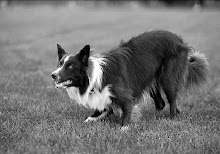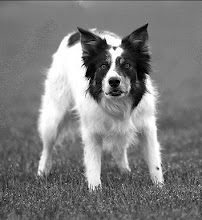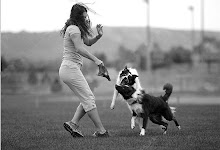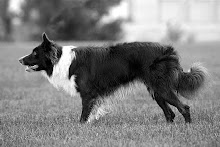 This week I've been training both dogs everyday. The usual routine is to work Summit for about 15 minutes then have him wait on the pause table while I work Sage. Then I finish up with a shorter 5-minute specific skills session with Summit (wp entries, contacts, etc.). The diagram above shows the different handler paths for each coordinating colored jump in the box. I love setting up these simple exercises.
This week I've been training both dogs everyday. The usual routine is to work Summit for about 15 minutes then have him wait on the pause table while I work Sage. Then I finish up with a shorter 5-minute specific skills session with Summit (wp entries, contacts, etc.). The diagram above shows the different handler paths for each coordinating colored jump in the box. I love setting up these simple exercises.I always begin Summit's session with basic RTH exercises focusing on collection. I use food as a reward since I want Summit calm and thinking. I use the flying squirrel (or other tug toy) to get him in drive for the speedwork. He is happy to accept the treats but every once in awhile, he turns to look at the table where the flying squirrel is laying there waiting.
Summit:
Straightline of jumps (bars set at 24"), into a box using lateral motion for a pull or a RC. Using deceleration and a forward send to cue a 180 degree wrap at the last jump in the box.
jump, tunnel, a-frame discrimination. Forward sends to the weavepoles varying my location (middle of poles, opposite end of poles, etc.).
I have not been leading out very far for the straightline of jumps. I don't race him but I do set a good running pace down the line. Monday he dropped several bars during each session. Today, he did not drop a single bar. I've spent a lot of time working on collection with Summit but not so much extension. Not that a Border Collie needs to learn how to extend over a jump, but (in Summit's case), how to jump extended without flattening out too much and dropping a bar.
Sage:
I've been working a lot of discriminations with Sage. Many including like obstacles (jumps). Other than the straighlines (which she doesn't need), I work many similar exercises with her that I do with Summit. It is very interesting to see the difference in how each dog will read my motion, location, and arm cues. This difference has nothing to do with Sage being unilaterally deaf as I rarely use verbals with Summit during training because I really want to see the effect the other cues have without relying on a verbal recall.
Summit has a pretty solid foundation in APHS; Sage does not. Sage will diverge off my line to take an obstacle, she also does not have as good an understanding of location cues. She is however, very good at reading motion. Its quite interesting to work both dogs on the same exercise and observe the differences.
So I've been attempting to fill in those holes in Sage's foundation training. Focusing more on incorporating more use of location and other arm cues (in addition to the OA collection/turn cue) to support my motion. Who knows, there may yet be a Super Q in her future!
Tomorrow morning we are taking a break from training and going swimming at Chatfield.
We have this weekend off and then the following weekend we will be travelling to Laramie, Wyoming for a 2 1/2 day USDAA trial, followed by a 2-day AKC trial, followed by 4 days in Salt Lake City, Utah for another AKC trial. A very busy three weeks!









No comments:
Post a Comment